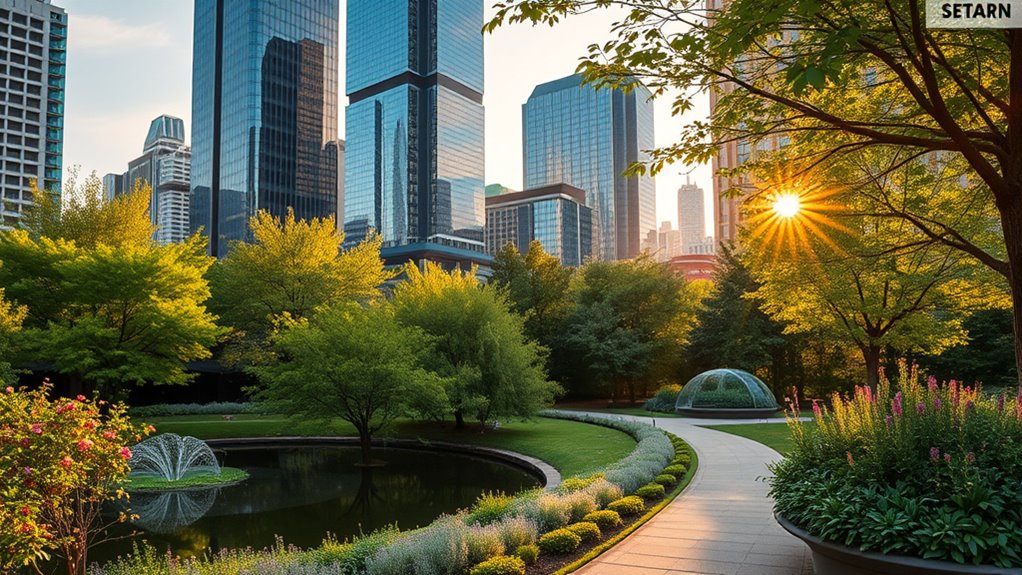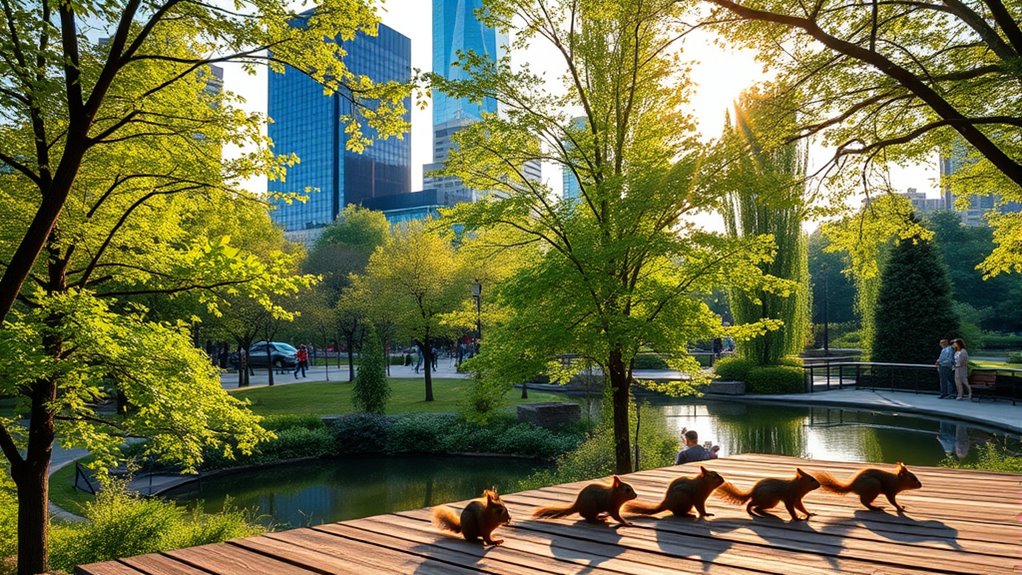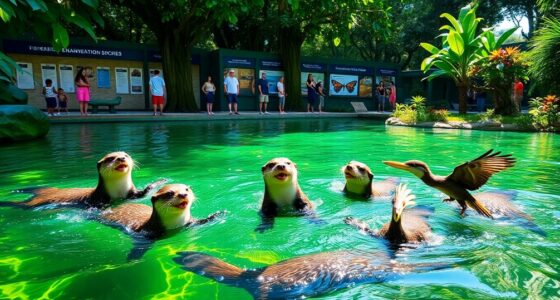You can help create urban wildlife havens by supporting green spaces like parks, community gardens, and green roofs. These areas act as refuges, connecting habitats for birds, insects, and small mammals, all while reducing habitat fragmentation. Promoting wildlife corridors, such as tree-lined routes and vegetated underpasses, enables animals to move safely through cities. Being part of local conservation efforts, planting native species, and advocating for policies can make a big difference in urban biodiversity—discover how to make your city more wildlife-friendly.
Key Takeaways
- Establish and protect green spaces like parks and community gardens to serve as vital habitats within urban areas.
- Develop wildlife corridors such as tree-lined pathways and green belts to connect isolated habitats and facilitate animal movement.
- Incorporate native plants in urban landscaping to support local biodiversity and provide food and shelter for wildlife.
- Implement policies and building codes that promote green infrastructure and habitat-friendly designs in urban development.
- Engage communities through conservation initiatives, planting native species, and raising awareness to foster urban biodiversity conservation.

Have you ever wondered how cities can play a crucial role in conserving the environment? It’s a common misconception that urban areas are disconnected from nature, but the truth is, they hold immense potential for promoting biodiversity. One of the most effective ways to achieve this is through the development and preservation of urban green spaces. Parks, community gardens, and green rooftops aren’t just aesthetic additions—they serve as essential refuges for local wildlife and offer residents a chance to reconnect with nature. When thoughtfully designed, these green areas become pockets of biodiversity within concrete jungles, providing habitats for birds, insects, and small mammals. They act as stepping stones, allowing wildlife to move safely across the city and reducing habitat fragmentation.
Urban green spaces nurture biodiversity and bring nature closer to city residents.
This is where wildlife corridors come into play. Think of them as natural highways that connect isolated green spaces, enabling animals to travel, forage, and breed without risking their safety. By establishing dedicated pathways—such as tree-lined pathways, green belts, or vegetated underpasses—you help facilitate the movement of wildlife through urban landscapes. This connectivity is essential because it prevents populations from becoming isolated, which can lead to genetic decline and increased vulnerability to disease. With well-planned wildlife corridors, you’re not just creating corridors for animals; you’re fostering a resilient urban ecosystem where biodiversity can thrive despite human development. Cities that prioritize these corridors also benefit from healthier ecosystems, improved air quality, and enhanced resilience against climate change.
Implementing these solutions requires active participation and strategic planning. You can advocate for policies that protect existing green spaces and promote the creation of new ones. Supporting local initiatives that develop community gardens or urban farms helps increase green cover and provides habitats for pollinators like bees and butterflies. Incorporating native plants into urban landscaping further supports local wildlife, ensuring they have access to familiar food sources and nesting sites. Additionally, understanding the importance of building codes and zoning laws can help ensure that new developments include provisions for green infrastructure and habitat preservation. As a city dweller, your involvement can make a difference—whether by participating in local conservation projects, lobbying for green infrastructure, or simply choosing to plant native species in your backyard or balcony.
Ultimately, creating urban green spaces and wildlife corridors isn’t just about beautifying the city; it’s about building a sustainable environment where humans and wildlife can coexist harmoniously. By conserving and expanding these natural habitats within cities, you’re contributing to global efforts to protect biodiversity and ensure a healthier planet for future generations.
Frequently Asked Questions
How Do Urban Wildlife Corridors Connect Fragmented Habitats?
Urban wildlife corridors connect fragmented habitats by creating green corridors that serve as safe passageways for animals. You can see how these corridors enhance habitat connectivity, allowing species to move freely between green spaces. This reduces habitat fragmentation, supports biodiversity, and promotes ecological balance within cities. By designing and maintaining these corridors, you help guarantee urban wildlife have continuous routes for migration, breeding, and foraging, making cities more sustainable and wildlife-friendly.
What Are the Best Native Plants for Urban Wildlife Gardens?
Ever imagined a vibrant garden teeming with life? You should choose native plant species like milkweed, coneflowers, and goldenrod for your urban wildlife garden. These native plants support habitat diversity, attracting pollinators, birds, and beneficial insects. By selecting native plant species, you create a sustainable, thriving environment that benefits local wildlife and enhances your city’s green spaces. Isn’t it rewarding to help nature flourish right outside your door?
How Can City Residents Monitor Local Biodiversity Effectively?
You can monitor local biodiversity effectively by participating in citizen science projects focused on biodiversity tracking. Use apps and online platforms to record sightings of native plants, insects, and birds in your area. Regularly document your observations, take photos, and share them with local conservation groups or databases. This active involvement helps you contribute valuable data, increases awareness, and supports urban biodiversity conservation efforts.
Are There Legal Protections for Urban Wildlife Species?
Think of urban wildlife like city residents with rights. Yes, legal frameworks and wildlife protections do exist for many species, but they vary by location. For example, some cities have laws to safeguard nesting birds or protect pollinators like bees. These legal protections help guarantee that urban flora and fauna thrive amid city life. Check local regulations to understand specific wildlife protections in your area and support conservation efforts.
How Does Urban Pollution Impact City-Based Ecosystems?
Urban pollution harms city-based ecosystems by degrading air quality and increasing noise pollution. You might notice smog and harmful emissions that make it harder for wildlife to breathe and thrive. Noise pollution from traffic and construction disturbs animals’ natural behaviors, causing stress and displacement. These factors reduce biodiversity and weaken the resilience of urban ecosystems, making it essential for you to support initiatives that improve air quality and reduce noise pollution for healthier city wildlife habitats.
Conclusion
As you weave green patches into cityscapes, you become a gardener of hope, nurturing tiny sanctuaries amid concrete jungles. Each effort plants seeds of change, turning urban gray into vibrant life. By creating these havens, you open gateways for wildlife to flourish, transforming your city into a symphony of coexistence. Remember, even small acts ripple outward, making your urban space a thriving oasis where nature and humanity blossom side by side.









